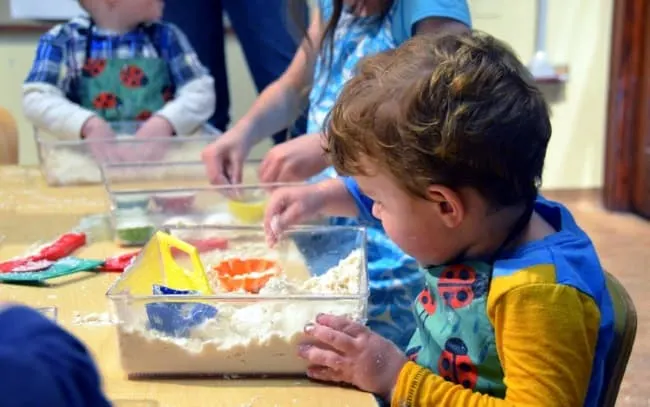
Play is often associated with something that happens after work or school. Parents and adults usually only play when they finish their daily household tasks and job. However, for kids, playtime is part of their daily routine, whether they completed their duties for the day or not.
When kids play, they’re actively learning and developing. The earlier years of a child’s life are crucial for their brain to grow as they observe new obstacles and think in new and creative ways. Therefore, when they play as a child, they’re continually learning skills essential for their future when they’ll learn to read, write and excel.
What Is Sensory Play?
You have probably heard of the term “sensory play” many times, whether from other parents or parenting articles. Many people associate it with things like kinetic sand, water, playdough and other tactile items.
Sensory play is about more than just touch, though. As the name suggests, it encompasses all human senses, including touch, taste, smell, sound, sight, body awareness and movement. Sensory play involves any age-appropriate activities that encourage children to explore and experience those senses.
Adding sensory play to your child’s daily routine is an excellent way for them to begin making sense of the world. Humans learn best and retain the most information when they can engage their senses.
Here are seven reasons parents should encourage sensory play with their children.
1. Supports Cognitive Development
First of all, sensory play supports cognitive development in children. This especially helps babies because, through using their senses, babies’ brains begin to develop nerve connections. Even as they grow older, they need to continue to be involved in sensory play to create connections and improve their ability to learn complex topics.
2. Encourages Fine and Gross Motor Skills
Another reason parents should encourage sensory play with their children is that it strengthens fine and gross motor skills. These are movements that involve both large and small muscles. When children play, they get better at sitting, walking, crawling, running, drawing, grasping and object manipulation.
3. Helps with Language Development
During sensory play, children use multiple senses at a time. This helps them learn descriptive words, and it may stimulate questioning. They may ask you how things work or things about the sensory play that’s occurring. Children can compare their environment and the objects within it to other environments, which helps them learn even more. For example, a tree soon becomes a sapling with rough-textured bark that has needles instead of leaves.
4. Allows for Creativity
Children get the chance to explore their creative side when engaged in sensory play. They love to sniff, listen, make patterns, squish, pull, pour, rub, stir and engage in all sorts of role-play activities. They stretch their imagination to new levels each time you provide them with a unique sensory experience. This also helps build problem-solving skills.
5. Calms Agitated Children
Sensory play can actually help calm children. It helps them regulate any internal discomfort, like restlessness or boredom. If you have ever noticed that your child is more relaxed after a rough play session of jumping and running or is calm after taking a bath and splashing around, you can thank sensory play. Sensory play gets their attention from that feeling and into whatever they’re doing because they’re absorbed in their activities.
6. Suits Any Environment
You can take sensory play anywhere, whether it’s inside or outside. Take your children into a bakery and have them smell all of the wonderful aromas. Visit a park and let them play on the playground equipment. Find a forest and let them get messy and explore. Put them in the tub with a few toys and bathtub markers that wash away. You can make sensory play fit any environment.
7. Engages All the Senses
Finally, parents should encourage sensory play because it engages all of the senses. Your child can better become more aware of their surroundings and environment the more senses they can use. It helps them categorize objects, discover new things about themselves and the world, and learn about their bodies and how senses work.
Ideas for Sensory Play
If you’re looking for ideas for sensory play beyond playdough or kinetic sand, you’ve come to the right place. Sensory play looks different depending on the age of your child, so choose ones that are age-appropriate and developmentally appropriate for your children. Below are a few great ideas for sensory play:
- Skin-to-skin contact is great for babies because, after birth, their sense of touch is highly developed.
- Finger painting allows children of all ages to explore textures, see new colors and mix colors.
- Dough and kinetic sand develop the hands and fingers. Babies and children can manipulate the dough to strengthen fine motor skills and make new shapes.
- Many parents opt for sensory bins, which is a small tub filled with various objects, whether they’re from nature or in the home. It allows little ones to explore new textures and scents.
- Older children can use sensory play, too, through something like a taste test challenge or helping you cook a meal.
These are all great ideas to start your sensory play experience with your children!
Exploring the Senses
The desire for sensory play often comes naturally for children. Encourage and support this interest at home from birth and beyond. It is one of the best ways to help your child develop mentally, socially, physically and emotionally.
- Sagittarius Man & Gemini Woman Love and Sex Compatibility - January 31, 2024
- Taurus Ascendant Rising Personality Traits in Men (Guide) - January 31, 2024
- How to Seduce and Attract a Sagittarius Man (Seduction Tips) - January 31, 2024
